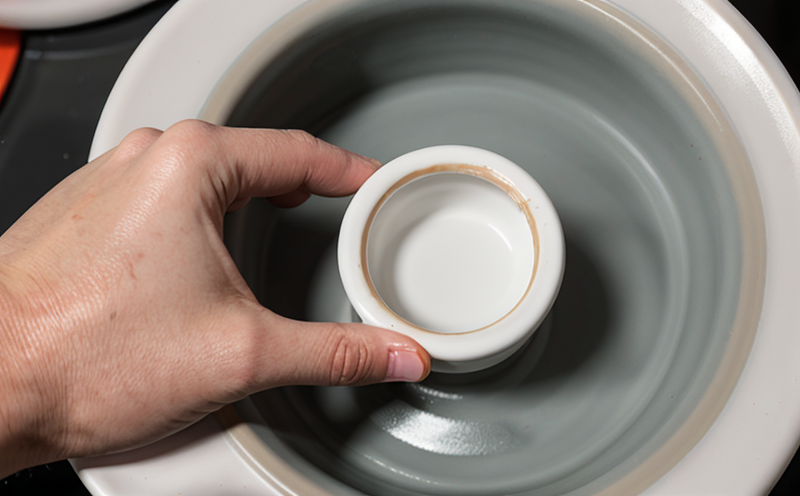ISO 23148 Tensile Strength Testing of Nanostructured Ceramic Components
The International Organization for Standardization (ISO) has established a specific protocol in ISO 23148, which provides guidelines for the tensile strength testing of nanostructured ceramic components. This standard is crucial for ensuring that nanostructured ceramics meet stringent quality and reliability requirements across various industries.
Nanostructured ceramics are characterized by their unique microstructure, which often exhibits properties not found in conventional materials. These advanced ceramics possess exceptional hardness, wear resistance, and thermal stability, making them suitable for a wide range of applications in sectors such as aerospace, automotive, and electronics. The tensile strength testing outlined in ISO 23148 is essential to validate the mechanical integrity and reliability of these components.
The test procedure involves subjecting nanostructured ceramic samples to controlled tensile forces until failure occurs. This process is designed to yield accurate measurements of the material's resistance under stress, which are critical for quality control and product development. Compliance with ISO 23148 ensures that manufacturers adhere to international standards, enhancing trust among customers and stakeholders.
For successful testing, it is important to follow the prescribed specimen preparation methods detailed in ISO 23148. This includes precise cutting of samples to standard dimensions, ensuring uniformity across all specimens used for testing. The use of advanced microstructural analysis techniques can further enhance the accuracy and reliability of these tests.
The testing apparatus recommended by ISO 23148 utilizes sophisticated equipment capable of applying controlled tensile forces with high precision. Ensuring that the test setup is correctly configured according to the standard's specifications is paramount for obtaining valid results. The acceptance criteria outlined in ISO 23148 provide clear guidelines on how to interpret and evaluate the test outcomes, ensuring consistency across different testing facilities.
In addition to mechanical integrity, nanostructured ceramics are often evaluated based on their chemical stability and thermal properties. These attributes are critical for applications where materials must withstand extreme conditions without degradation. Testing methods such as ISO 23148 complement these evaluations by providing additional insights into the material's overall performance.
The process of tensile strength testing is not only beneficial for quality assurance but also plays a pivotal role in research and development efforts aimed at improving nanostructured ceramics. By adhering to international standards like ISO 23148, manufacturers can ensure that their products meet the highest level of performance expectations.
Industry Applications
- Aerospace: Ensuring lightweight and high-strength components for aircraft structures.
- Automotive: Developing durable materials for engine parts and exhaust systems.
- Electronics: Creating resilient insulators and conductors in semiconductor manufacturing processes.
Quality and Reliability Assurance
The tensile strength testing of nanostructured ceramic components, as per ISO 23148, is a cornerstone for quality and reliability assurance. By adhering to this standard, manufacturers can ensure that their products consistently meet the stringent requirements set forth by international standards. This not only enhances product performance but also builds trust among clients and stakeholders.
The testing process involves several key steps aimed at verifying the mechanical properties of nanostructured ceramics. These include specimen preparation, which must be carried out meticulously to ensure uniformity across all samples. The use of advanced microstructural analysis techniques can further enhance the accuracy and reliability of these tests by providing detailed insights into the material's structure.
The testing apparatus recommended in ISO 23148 utilizes sophisticated equipment capable of applying controlled tensile forces with high precision. Ensuring that the test setup is correctly configured according to the standard’s specifications is crucial for obtaining valid results. The acceptance criteria outlined in ISO 23148 provide clear guidelines on how to interpret and evaluate the test outcomes, ensuring consistency across different testing facilities.
Compliance with this international standard goes beyond merely meeting regulatory requirements; it also fosters continuous improvement within manufacturing processes. By adhering to ISO 23148, companies can identify areas for enhancement and implement necessary changes to maintain high standards of product quality.
The results obtained from tensile strength testing are invaluable in identifying any inconsistencies or defects that may affect the performance of nanostructured ceramic components. These findings enable manufacturers to take corrective actions promptly, thereby preventing potential failures in end-user applications.
Use Cases and Application Examples
- In aerospace engineering, nanostructured ceramics are used for manufacturing lightweight yet highly durable components that can withstand the extreme conditions encountered during space missions.
- In automotive applications, these materials find use in engine parts and exhaust systems where their exceptional wear resistance is crucial.
- For electronics manufacturers, nanostructured ceramics serve as resilient insulators and conductors in semiconductor manufacturing processes, ensuring reliable performance under various environmental conditions.
The tensile strength testing of nanostructured ceramic components plays a vital role in these applications by providing critical data on the mechanical properties of these advanced materials. This information is essential for optimizing designs and enhancing overall product reliability.





